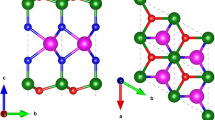Abstract
A stable planar allotrope of MoS2, formed by introducing four- and eight-membered rings into its hexagonal network (H468), is identified to be a narrow direct-band-gap semiconductor by first principle calculations, which is remarkably different from the large band gap semiconductor of conventional MoS2 and also the zero band gap allotrope consisting of four- and eight-membered rings (H48) only. The medium-sized direct band gap indicates that H468 would find applications in nanoelectronics and near-infrared optoelectronic devices. Furthermore, the distinctive simulated scanning tunneling microscope images under positive and negative biases might be a unique characteristic for the experimental identification of such an allotrope of MoS2.




Similar content being viewed by others
References
Baroni S, de Gironcoli S, Dal Corso A, Giannozzi P (2001) Phonons and related crystal properties from density-functional perturbation theory. Rev Mod Phys 73:515
Blöchl P (1994) Projector augmented-wave method. Phys Rev B 50:17953
Castro Neto A, Guinea F, Peres N, Novoselov K, Geim A (2009) The electronic properties of graphene. Rev Mod Phys 81:109
Crespi V, Benedict L, Cohen M, Louie S (1996) Prediction of a pure-carbon planar covalent metal. Phys Rev B 53:R13303
Eda G, Yamaguchi H, Voiry D, Fujita T, Chen M, Chhowalla M (2011) Photoluminescence from chemically exfoliated MoS2. Nano Lett 11:5111
Jang MS, Kim H, Son Y-W, Atwater HA, Goddard WA (2013) Graphene field effect transistor without an energy gap. Proc Natl Acad Sci USA 110:8786
Kim S, Konar A, Hwang W-S, Lee JH, Lee J, Yang J, Jung C, Kim H, Yoo J-B, Choi J-Y, Jin YW, Lee SY, Jena D, Choi W, Kim K (2012) High-mobility and low-power thin-film transistors based on multilayer MoS2 crystals. Nat Commun 3:1011
Kotakoski J, Krasheninnikov AV, Kaiser U, Meyer JC (2011) From point defects in graphene to two-dimensional amorphous carbon. Phys Rev Lett 106:105505
Li W, Guo M, Zhang G, Zhang Y-W (2014) Gapless MoS2 allotrope possessing both massless dirac and heavy fermions. Phys Rev B 89:205402
Lisenkov SV, Vinogradov GA, Astakhova TY, Lebedev NG (2005) Nonchiral BN haeckelite nanotubes. J Exp theor Lett 81:346
Mak KF, Lee C, Hone J, Shan J, Heinz TF (2010) Atomically thin MoS2: a new direct-gap semiconductor. Phys Rev Lett 105:136805
Meric I, Han MY, Young AF, Ozyilmaz B, Kim P, Shepard KL (2008) Current saturation in zero-bandgap, top-gated graphene field-effect transistors. Nat NANO 3:654
Monkhorst H, Pack J (1976) Special points for brillouin-zone integrations. Phys Rev B 13:5188
Muscat J, Wander A, Harrison NM (2001) On the prediction of band gaps from hybrid functional theory. Chem Phys Lett 342:397
Najmaei S, Liu Z, Zhou W, Zou X, Shi G, Lei S, Yakobson BI, Idrobo J-C, Ajayan PM, Lou J (2013) Vapour phase growth and grain boundary structure of molybdenum disulphide atomic layers. Nat Mater 12:754
Novoselov K (2007) Graphene: mind the gap. Nat Mater 6:720
Novoselov KS, Geim AK, Morozov SV, Jiang D, Zhang Y, Dubonos SV, Grigorieva IV, Firsov AA (2004) Electric field effect in atomically thin carbon films. Science 306:666
Paolo G, Stefano B, Nicola B, Matteo C, Roberto C, Carlo C, Davide C, Guido LC, Matteo C, Ismaila D, Andrea Dal C, de Stefano G, Stefano F, Guido F, Ralph G, Uwe G, Christos G, Anton K, Michele L, Layla M-S, Nicola M, Francesco M, Riccardo M, Stefano P, Alfredo P, Lorenzo P, Carlo S, Sandro S, Gabriele S, Ari PS, Alexander S, Paolo U, Renata MW (2009) QUANTUM ESPRESSO: a modular and open-source software project for quantum simulations of materials. J Phys Condens Matter 21:395502
Perdew J, Burke K, Ernzerhof M (1996) Generalized gradient approximation made simple. Phys Rev Lett 77:3865
Perera MM, Lin M-W, Chuang H-J, Chamlagain BP, Wang C, Tan X, Cheng MM-C, Tománek D, Zhou Z (2013) Improved carrier mobility in few-layer mos2 field-effect transistors with ionic-liquid gating. ACS Nano 7:4449
Song J-W, Giorgi G, Yamashita K, Hirao K (2013) Communication: singularity-free hybrid functional with a Gaussian-attenuating exact exchange in a plane-wave basis. J Chem Phys 138:241101
Terrones H, Terrones M (2014) Electronic and vibrational properties of defective transition metal dichalcogenide haeckelites: new 2D semi-metallic systems. 2D Mater 1:011003
Terrones H, Terrones M, Hernández E, Grobert N, Charlier JC, Ajayan P (2000) New metallic allotropes of planar and tubular carbon. Phys Rev Lett 84:1716
Tersoff J, Hamann DR (1985) Theory of the scanning tunneling microscope. Phys Rev B 31:805
van der Zande AM, Huang PY, Chenet DA, Berkelbach TC, You Y, Lee G-H, Heinz TF, Reichman DR, Muller DA, Hone JC (2013) Grains and grain boundaries in highly crystalline monolayer molybdenum disulphide. Nat Mater 12:554
van Schilfgaarde M, Kotani T, Faleev S (2006) Quasiparticle self-consistent $GW$ theory. Phys Rev Lett 96:226402
Zhang C, Johnson A, Hsu C-L, Li L-J, Shih C-K (2014) Direct imaging of band profile in single layer MoS2 on graphite: quasiparticle energy gap metallic edge states, and edge band bending. Nano Lett 14:2443
Zhao W, Ribeiro RM, Toh M, Carvalho A, Kloc C, Castro Neto AH, Eda G (2013) Origin of indirect optical transitions in few-layer MoS2, WS2, and WSe2. Nano Lett 13:5627
Acknowledgments
Authors thank the start-up funding support from Huaiyin Normal University.
Author information
Authors and Affiliations
Corresponding author
Rights and permissions
About this article
Cite this article
Zhu, L., Zhang, T. Suppressing band gap of MoS2 by the incorporation of four- and eight-membered rings. J Nanopart Res 17, 220 (2015). https://doi.org/10.1007/s11051-015-3030-5
Received:
Accepted:
Published:
DOI: https://doi.org/10.1007/s11051-015-3030-5




